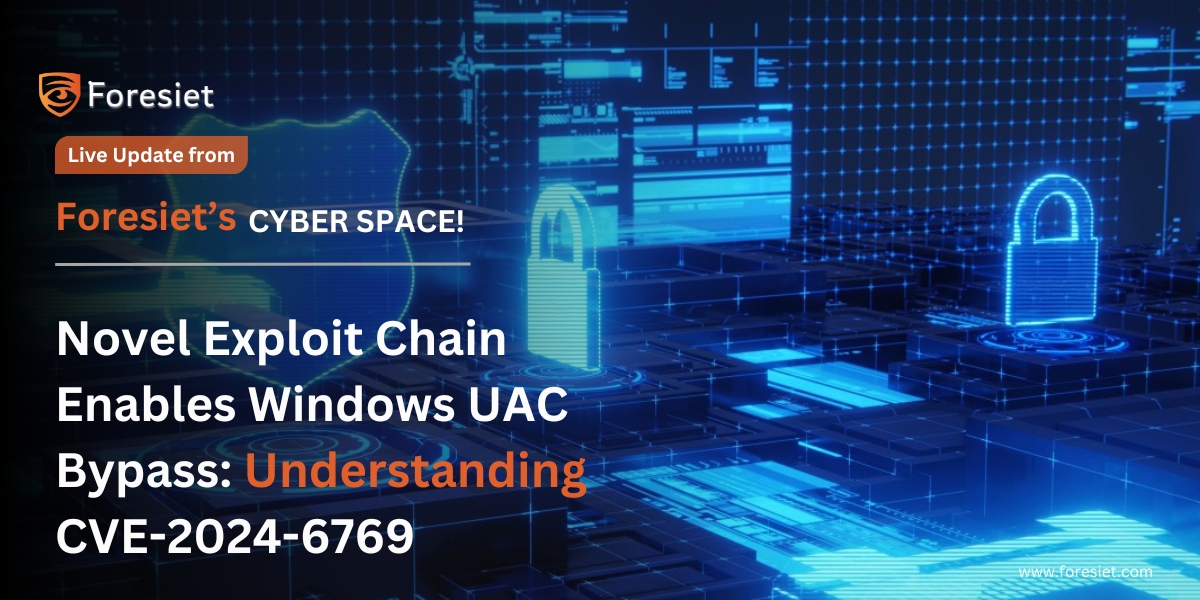Novel Exploit Chain Enables Windows UAC Bypass: Understanding CVE-2024-6769

Introduction
Researchers have uncovered a new vulnerability, tracked as CVE-2024-6769, which enables attackers to bypass Windows User Access Control (UAC) and elevate their privileges to gain full system control without triggering any alerts. This exploit, affecting Microsoft’s Windows platform, has sparked debate about whether UAC truly acts as a security boundary. While Microsoft does not classify this as a vulnerability, security experts warn organizations to be vigilant about the risks involved. In this blog, we explore the details of the CVE-2024-6769 exploit, how it operates, and what businesses should do to protect their systems.
The Nature of CVE-2024-6769
CVE-2024-6769 is classified as a UAC bypass and privilege escalation vulnerability, meaning that an attacker who has already gained access to a system at a lower integrity level can use this exploit to elevate their privileges to full administrative control without triggering UAC prompts. This weakness could allow attackers to manipulate system files, shut down the system, and perform other malicious activities, particularly targeting environments with weak user controls.
Fortra, the security firm that discovered the exploit, assigned it a medium severity score of 6.7 on the Common Vulnerability Scoring System (CVSS) scale. According to their analysis, this exploit allows attackers to write and delete files in sensitive locations, such as the C:\Windows directory, which should typically be reserved for SYSTEM users only.
How the Exploit Works: Bypassing UAC
To understand the mechanics behind this exploit, we need to revisit the Mandatory Integrity Control (MIC) model introduced in Windows Vista. This model assigns different integrity levels to users, processes, and resources: low for untrusted applications, medium for authenticated users, high for administrators, and system for the most critical processes. UAC is the mechanism that enforces this model, prompting users for consent before actions requiring higher privileges.
However, the CVE-2024-6769 exploit allows attackers to jump from medium integrity to high integrity without triggering UAC. By combining two distinct techniques, the attacker gains full administrative privileges without user awareness.
Key Steps in the Exploit:
- Initial Access: The attacker begins with access to a system under an account that is part of the administrator group but lacks full administrative privileges due to UAC.
- Drive Remapping: The attacker remaps the system’s root drive (e.g., "C:") to a location they control, moving critical directories like system32. This trick enables them to place a malicious DLL in a new system32 folder, which is then loaded by trusted services such as ctfmon.exe, which runs at a high integrity level without administrator privileges.
- DLL Injection: Once the DLL is loaded, the attacker gains high integrity access, allowing them to run processes with full administrative control.
- Activation Context Cache Poisoning: The final step involves manipulating the Windows activation context cache, which loads specific versions of system libraries. By poisoning this cache, the attacker ensures that malicious files are loaded instead of legitimate ones, granting them full system privileges.
Microsoft's Perspective: Not a Vulnerability
Despite the risks posed by this exploit, Microsoft has maintained that CVE-2024-6769 does not qualify as a vulnerability. The company argues that the "boundary" between administrator and system-level users is not a robust security boundary in Windows. In their view, since administrators already have significant control over a device, bypassing UAC is not considered a critical security issue.
Microsoft's stance aligns with its Security Servicing Criteria for Windows, which states that administrative users are part of the Trusted Computing Base (TCB) and are thus not strongly isolated from system-level actions. According to this reasoning, an administrator can already disable security features or uninstall updates, so crossing the boundary from administrator to system does not represent a significant breach of security.
Fortra's Take: UAC as a Security Feature
However, security experts at Fortra disagree with this perspective. When UAC was introduced, it was marketed as a key security feature designed to protect against unauthorized privilege escalation. By allowing an exploit that bypasses UAC, they argue, Microsoft undermines the security protections that UAC was supposed to provide.
For organizations, the philosophical difference is critical. If UAC is not treated as a true security boundary, it becomes easier for attackers to gain control over a system once they have initial access. This could have serious implications for environments that rely on UAC to limit the actions of administrative accounts.
What Organizations Should Do
While Microsoft may not see this as a high-risk vulnerability, organizations still need to take precautions to protect against potential exploitation. Allowing lower-integrity administrators to escalate privileges to full system control can be dangerous, enabling attackers to:
- Upload malware
- Disable security features
- Manipulate or delete critical system files
- Access sensitive data
- Establish persistence on the system
Here are some key measures businesses can adopt:
- Stolen Credentials Detection: Implement tools to monitor for unauthorized use of administrative credentials.
- Digital Footprint Analysis: Regularly assess your system’s security posture to identify potential weaknesses, especially in privileged accounts.
- Multi-Factor Authentication (MFA): Enforce MFA for all administrative accounts to prevent attackers from easily gaining access to these credentials.
- Limit Privileges: Ensure that administrative accounts are only given the minimum privileges necessary to perform their tasks, reducing the attack surface.
- Monitor Administrative Actions: Use monitoring tools to track all actions taken by administrative accounts, flagging any suspicious behavior that could indicate a UAC bypass attempt.
- Patch Vulnerabilities: Regularly update your systems to protect against known vulnerabilities that could be exploited in conjunction with CVE-2024-6769.
Conclusion
The CVE-2024-6769 exploit presents a new avenue for attackers to bypass Windows User Access Control and escalate privileges without detection. While Microsoft may not classify this as a vulnerability, businesses should remain aware of the risks and take proactive measures to secure their systems. With robust monitoring and strong access controls, organizations can mitigate the risks posed by this and similar threats, ensuring that their systems remain secure.
About Foresiet!
Foresiet is the pioneering force in digital security solutions, offering the first integrated Digital Risk Protection SaaS platform. With 24x7x365 dark web monitoring and proactive threat intelligence, Foresiet safeguards against data breaches and intellectual property theft. Our robust suite includes brand protection, takedown services, and supply chain assessment, enhancing your organization's defense mechanisms. Attack surface management is a key component of our approach, ensuring comprehensive protection across all vulnerable points. Compliance is assured through adherence to ISO27001, NIST, GDPR, PCI, SOX, HIPAA, SAMA, CITC, and Third Party regulations. Additionally, our advanced antiphishing shield provides unparalleled protection against malicious emails. Trust Foresiet to empower your organization to navigate the digital landscape securely and confidently.
Protect your brand, reputation, data, and systems with Foresiet's Integrated Digital Risk Platform. 24/7/365 threat monitoring for total peace of mind.


July 10, 2025, 9 a.m.
